Towards fast commuting
Many Dutch cities and regions already have them; Copenhagen is building an extensive network, and so does London: fast cycling routes are seeing the light in many places in Europe.
These fast cycling routes particularly aim at commuters and have a huge potential to get more people cycling more often and to reach European ambitious targets in terms of cycling development.
On this webpage, ECF collects the latest knowledge concerning fast cycling routes and some of the best examples from Europe.
Definition
According to Michael W J Sørensen (2012), fast cycling routes are “high standard bicycle paths reserved for cyclists for fast and direct commuting over long distances.”
Criteria of fast cycling routes
National design manuals have laid down the 5 criteria for cycling infrastructure:
- Safety.
- Coherence.
- Directness.
- Comfort.
- Attractiveness.
It speaks for itself that these criteria apply to fast cycling routes as well. In addition to these 5 criteria, the integration into public space is accepted as a 6th criterion in different regions such as the province of Flemish-Brabant (Belgium). Beyond that, additional commonly agreed criteria and characteristics do not exist yet as the concept of fast cycling routes is relatively new.
Individual projects however have listed these characteristics:
Fast cycling routes should:
- be at least 5 km long
- be ≥3.0m wide if one-directional, ≥4.0 m if bi-directional routes (in North-Rhine Westphalia – NRW)
- be separated both from motorized traffic and pedestrians (NRW)
- avoid steep climbs and prioritize mild gradients
- avoid frequent stops e.g. by giving priority at crossings to enable an average speed of 20km/h (CPH)
- provide regular maintenance and services such as winter service, public lighting, service stations, etc. (NL, NRW, CPH)
Fast Cycling Routes and new cycling trends
Fast cycling routes could contribute to the development of other current cycling trends, namely e-bikes and cargo-bikes.
The development of fast cycling routes comes at a time where many urban centres face the same challenges, in particular congestion and pollution. Growing urban centres add to these challenges and force cities to find new solutions. This coincides with new trends within the cycling sector, including public bike-sharing, electrification of transport vehicles (e-bikes), goods delivery by cargo-bikes… As more people cycling longer distances more often and on larger bicycles with higher (average) speed, this calls for an upgrade in cycling infrastructure: fast cycling routes.
The Location
Fast cycling routes are generally located in densely populated urban areas to connect living places with places of high activity (work places, schools, shops). They can also be found between major cities and surrounding towns or between a series of towns and/or cities.
The Users
The primary target group is people who commute 5 kilometers or more to their destination.
In London for instance 85% of the trips on the cycle super highways are commutes (Transport for London, 2011). However, a study led by Provincie Vlaams-Brabant (Fietstellingen HST-route, 2012) in Flanders shows that (only) one trip out of two on the fast cycling route between Leuven and Brussels is a commute (remaining 50% are recreational).
The Belgian study shows that the fast cycling route is used for trips from less than one kilometer to more than 50 kilometers. Half of these trips are longer than 17 kilometers.
The average user of the fast cycling route between Leuven and Brussels:
- Is a middle-aged cyclist (89% of the users are between 25 and 64)
- Cycles several times a week (80% of the users cycle at least 3 days per week)
- Cycles an average distance of 19 kilometers.
Management of the infrastructure
The size of such projects often needs the collaboration of different organisations as well as the coordination of the activities by a single entity.
The case of Copenhagen:
- 22 municipalities (local level), Copenhagen region (regional level) and the Danish Road Directorate (national level) cooperate to build Copenhagen’s network.
- A common secretariat attached to the commune of Copenhagen is in charge of the coordination of the project.
The case of Arnhem & Nijmegen region:
- The Cityregion Arnhem Nijmegen, 20 municipalities, surrounding municipalities in Gelderland and Noord Brabant, the Cyclists Association, the province of Gelderland, the surrounding provinces of Limburg and Noord Brabant, the Ministry of Infrastructure and Environment are working together.
- A single coordinator attached to Cityregion Arnhem Nijmegen is in charge of the coordination.
Funding
The level of capital investment depends on several factors: new infrastructure or upgrade of existing infrastructure; topographic challenges; the level of ambition regarding quality (e.g. width); average speed… Expensive pieces of infrastructure, in particular bridges and tunnels, can drive up the costs. Therefore, average costs of current projects vary from about €0.2 to 1.9 million per km.
Considering the significance of the investments, national and/or regional governments contribute substantially to the investments in fast cycling routes, eg: 50% from national government in Denmark, 40% from Flanders region and 40% from provinces in Belgium. Preliminary talks between the European Investment Bank (EIB) and the Netherlands could lead to loans by the EIB.
The benefits
Thanks to the high levels of quality, safety and speed they provide, fast cycling routes contribute to get more people cycling. In London, it is estimated that in one year, cycling along cycle superhighways has grown by 46 per cent and by 83 per cent, on route 7 and route 3 respectively .
In decreasing the number of cars, fast cycle routes play an important role in congestion-easing. A feasibility study carried out for the 100-kilometer fast cycle route in North-Rhine Westphalia came to the conclusion that up to 50,000 cars could be taken off the regional road network every day. The Benefit-Cost Ratio of that project is up to 4.8:1.
A study conducted by Goudappel Coffeng (Cycle freeways, what are the benefits?, 2012) confirmed that fast cycling routes in the Netherlands could lead to major savings. Each year, fast cycling routes could save €40 million for congestion-easing, €100 million for health expenses and €4 million for a reduction in pollution emission nationwide. The overall figure of €144 million could even rise up to €358 million in a scenario where half of the bicycles are e-bikes. These figures should be compared to an estimated one-time construction cost of €700 million.
Best Cases
We propose here to follow the developments of existing and future best cases in Europe and to provide key documents for each project.
The Snelle Fietsroutes – Netherlands
The Netherlands are a pioneer in the field of fast cycling routes. A first Snelle Fietsroute (fast cycle route) has been inaugurated in 2003. Located between Breda and Etten-Leur, the route already had all the characeristics of a modern fast cycling route. This 7-km route is perfectly rideable (smooth surface) and large enough (min. 3.5m) to allow users to pass slower cyclists. The junctions have also been secured with the use of traffic lights to make the use of the route as safe as possible.
Nowadays, public authorities and cycling associations aim at creating 675 km of Snelle Fietsroutes (fast cycle routes) around the country’s cities by 2o25. For this purpose, in September 2013, Hugo van der Steenhoven, director of Fietsersbond and Ingrid de Bondt, Member of Parliament from Southern Holland presented to the national Minister in charge of infrastructure and environment, Melanie Schultz van Haegen, a detailed agenda for the future of Snelfietsroutes. Several provinces gave their commitment for the construction of the first new fast cycle routes.
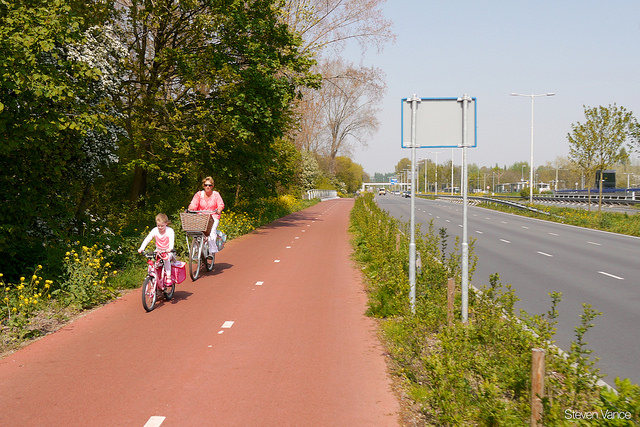
- Name: Snelle Fietsroutes
- Total length: 675 km (by 2025 – objective)
- Place: Netherlands (nation-wide)
- Major metropolitan areas: Amsterdam (pop. 1.6 million), Rotterdam (pop. 1 million), The Hague (pop. 1 million)…
- Date of completion: 2025
- State of progress: under construction. In 2013: 18 existing routes and 7 under construction
- Estimated cost: €7oo million – approximately €1 million per kilometer
- Funding: Ministry of Infrastructure and Environment (20% – 30%), local and regional - authorities (70% – 80%) including municipalities (25% – 50% of the total amount).
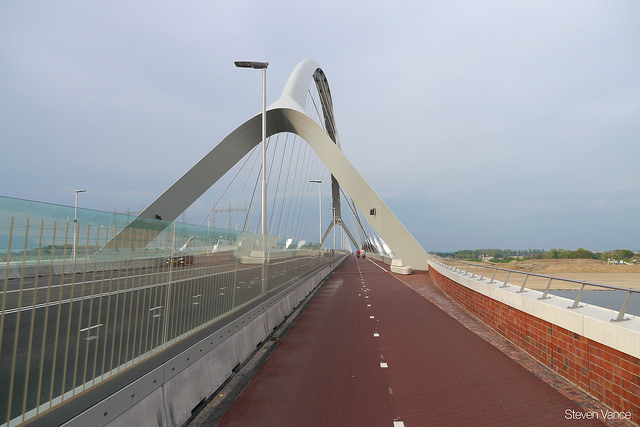
Sources:
Website: www.fietssnelwegen.nl
Agenda for the future of Snelfietsroutes (in Dutch)
Map of the network
Pictures: Steven Vance – Flickr – CC – Cycle infrastructure and De Oversteek – The Crossing
The Supercykelstier – Greater Copenhagen (DK)
The Supercykelstier (Super Bike Paths) is a network of fast cycling routes in the region of the Greater Copenhagen. Once completed, the network should be 500 km long and will connect Copenhagen with more than twenty surrounding municipalities. The network will be composed of a limited number of concentric circular roads and multiple radials.
Thanks to the high quality of the roads (smooth pavement, snow removal…) and some technical services such as the coordination of traffic lights, cyclists will have the opportunity to ride from their home to various places of activity at an average speed of 20 km/h.
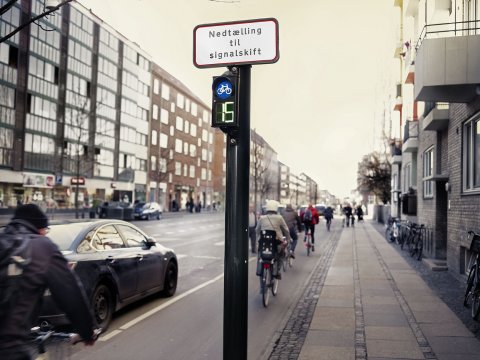
- Name: Supercykelstier
- Total length: 500km
- Place: Greater Copenhagen (Copenhagen and more than 20 surrounding municipalities – pop. 2 million)
- State of progress: under construction – 8% in place, 32% by 2018
- Estimated cost: €55 million to €118 million – €0.11 million to €0.36 million per kilometer
- Common secretariat: Copenhagen municipality
Sources:
Website: supercykelstier.dk (in Danish and in English)
Presentation in English (May 2014)
Picture: Cycle Super Highways, Capital Region Copenhagen
The Fietsostrade – Flanders (BE)
In Belgium, Fietsostrades (Bike highways) are mostly located in Flanders. The different provinces of the regional state are in charge of the development of the fast cycling routes. Consequently, national and/or regional figures are not available yet.
Generally speaking, the network of fast cycling routes is well-developed. Flanders as a regional state co-finances the construction of fast cycling routes (40%) together with provinces (40%) and municipalities (20%)
You will find below some of the best cases:
Province of Antwerp:
- Antwerp – Mechelen (23 km – 98% in place)
- Herentals – Balen (app. 26 km – 40% in place)
- Antwerp – Essen (app. 33 km – 84% in place)
- Antwerp – Lier (app. 10 km – 30% in place)
- Source: Provincie Antwerpen (in Dutch)
Province of Flemish Brabant:
- Halle – Brussels – Grimbergen/Vilvoorde (app. 35 km)
- Leuven – Brussels (app. 31 km)
- Asse – Brussel (14 km)
- Aarschot – Leuven (app. 16 km)
- Leuven-Tienen (18 km)
- Source: Provincie Vlaams Brabant (in Dutch)
Province of East Flanders:
- Construction of 20 km of fast cycling routes per year. Annual budget of €2.5 million (from the province)
- Gent – Antwerp (43 km)
- Map of the network
- Source: Provincie Oost-Vlaanderen (in Dutch)
Picture: Provincie Oost-Vlaanderen
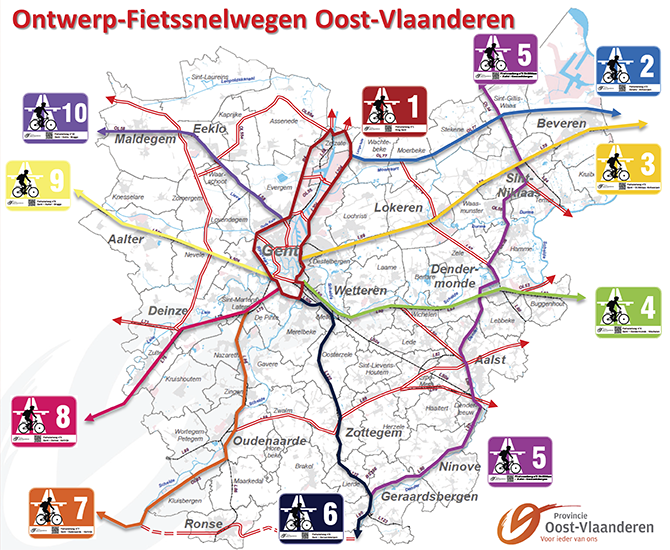
Province of West Flanders:
- The Province of West Flanders has an annual budget of €10 million for cycling infrastructures.
- The province co-finances the construction of fast cycling routes. In addition to the usual share of 40%, the province proposes to pay the municipalities’ share (20%) of each project.
- Tussen Marke en Zwevegem – Knokke (10 km)
- Provinicie West-Vlaanderen (in Dutch)
Province of Limburg:
- Lijn 18: Genk – Hamont-Achel (40 km)
- Website: Provincie Limburg (in Dutch)
The Cycle Superhighways – London (UK)
London is the biggest city in Europe to have a fast cycling routes network. The British Capital’s routes, called ‘Barclays Cycle Superhighways’ aim at providing “safer, faster and more direct journeys” between central and outer London. The network is recognizable at first glance thanks to the blue paint which covers the Cycle Superhighways.
The Cycle Superhighways project provides cycle routes (up to 15 km long and at least 1.5 m wide and often one-way) but it also contributes to making cycling in London easier. By way of example, one of the major supporting measures is the creation of thousands of cycle parking places along the Cycle Superhighways. The city authorities aim at increasing the practice of cycling in London by 400% by 2026 compared to 2000.
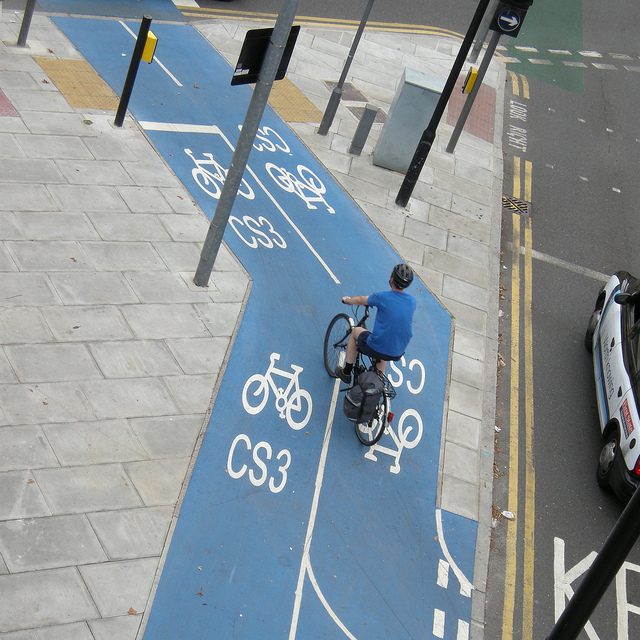
- Name: Barclays Cycle Superhighways
- Total length: N.A. (Routes are from 5 km to 15 km long – The initial planned network was composed of 12 routes)
- Place: London (pop. urban area: 10 million)
- State of progress: under construction. 2014: 4 existing routes (CS 2, CS 3, CS 7 and CS 8) for a total of 41 km. 2016: opening of new routes.
- Estimated cost: €140 million – approximately 1€ million per kilometer
- Funding: City of London, Transport for London (TfL), Sponsoring by Barclays (£50 mio. = €63 mio.)
Sources:
- Website: www.tfl.gov.uk
- FAQs
- Evaluation of routes CS 3 and CS 7
Picture: Martin Deutsch – Flickr – CC – CS3
The Radschnellwege – North-Rhine Westphalia (DE)
The Radschnellege (Fast cycle route in German) links a series of towns in the largest urban agglomeration in Germany: the Ruhr (in North-Rhine Westphalia region). The 100-km fast cycling route will connect 10 major cities of the region, including Dortmund, Essen and Duisburg which have all more than 500,000 inhabitants.
This linear fast cycling route is expected to attract daily between 1,000 and 4,000o cyclists on each section. As a consequence, the Radschnellweg Ruhr could have a strong congestion-easing impact in the region. It has been estimated that 50,000 cars could be taken off the regional roads thanks to this single cycle route.
- Name: Radschnellweg Ruhr RS1
- Length: 100 km
- Place: Ruhr area (North-Rhine Westphalia – Germany)
- Major cities: Dortmund (pop. 580,000), Essen (pop. 575,000), Duisburg (pop. 500,000), Bochum (pop. 385,000)…
- Date of completion: 2020
- State of progress: under construction
- Estimated cost: €183.7 million – €1.8 million per kilometer
- Funding: North-Rhine Westphalia region (80%) and local governments (20%)
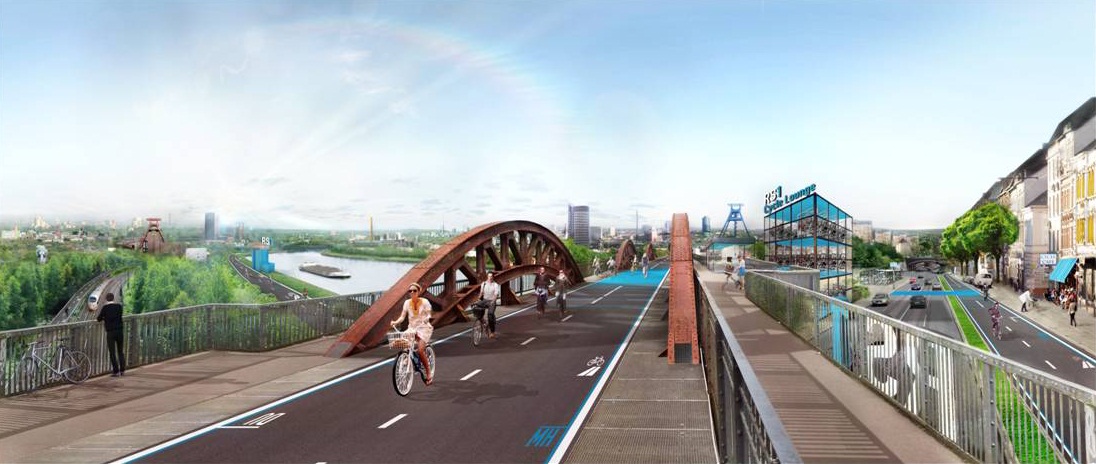
Picture: Metropoleruhr
Sources:
Website: www.rs1.ruhr
Feasibility study (in German)
Brochure (in German)
The Vélostras – Strasbourg (FR)
Strasbourg is already the most cyclist-freindly city in France and thanks to Vélostras it hopes to reach a 16% cycling modal share by 2025. The future network of fast cycling routes will be composed of 3 concentric circular cycle routes and 9 radials connecting the heart of the city to the surrounding towns. It will also integrate the local sections of EuroVelo 5 and EuroVelo 15 into the network.
An average speed of 20 km/h is expected on the network which will be perfectly rideable 24 hours per day and 365 days per year. Public lightning, winter service and regular maintenance will be provided on the entire network.
- Name: Vélostras
- Length: 130 km
- Place: Urban area of Strasbourg (pop. 470,000)
- Date of completion: 2020
- State of progress: under construction (the 2nd circular route of 12 km is existing)
- Funding: Communauté Urbaine de Strasbourg
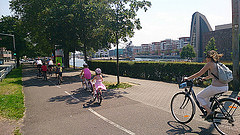
Sources:
Website: www.strasbourg.eu (in French)
Map of the network
Picture: Víctor Quiroz – Flickr – CC
The Supercykelväg – Malmö – Lund (SW)
The first four-lane fast cycling route in Sweden will connect Malmö to Lund (going through Hjärup, Åkarp and Arlöv as well). Due to its size (third biggest city in Sweden) and its connection with Copenhagen (via the Øresund Bridge), Malmö is one of the most dynamic cites in Sweden. 16 kilometers from Malmö, Lund is home to the regional leading University and some of the most important industries of the region. The construction of a fast cycling route is therefore appropriate between the two cities.
The Supercykelväg would be a four-lane route, which will allow easy overtaking. Wind protections are also expected to be built to counter the strong Scanian wind.
- Name: Supercykelväg
- Length: 16 km
- Place: Province of Scania (Southern Sweden)
- Majorcities: Malmö (pop. 300,000), Lund (pop. 115,000)
- Date of completion: 2018
- State of progress: under construction
- Estimated cost: €5.5 million – €0.34 million per kilometer
- Funding: Malmö (€3.14 million) and Lund
Sources:
Websites: Lund and Malmö
Brochure (in Swedish)
News articles (in Swedish and in English)
Download our factsheet: Fast Cycling Routes: towards barrier-free commuting (December 2014)
Have we missed a fast cycling route project? Please contact us at f.kuester@ecf.com.
